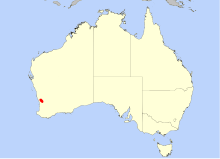Drosera closterostigma
| Drosera closterostigma | ||||||||||||
|---|---|---|---|---|---|---|---|---|---|---|---|---|

Drosera closterostigma , flower |
||||||||||||
| Systematics | ||||||||||||
|
||||||||||||
| Scientific name | ||||||||||||
| Drosera closterostigma | ||||||||||||
| NGMarchant & Lowrie |
Drosera closterostigma is a carnivorous plant from the genus sundew ( Drosera ). It belongs to the group of so-called dwarf sundews and is native to southwestern Australia.
description
Drosera closterostigma is a perennial herbaceous plant . This rosette-forming dwarf sundew reaches a diameter of about 1.8 cm. The stem axis is 5 mm long and only covered with few or no withered leaves from the preseason.
The bud of the stipules is ovate, smooth, 5 mm long and 4 mm in diameter at the base. The stipules themselves are 4 mm long, 3 mm wide and three-lobed. The middle lobe is divided into 3 segments, which in turn are divided into 2 fringes.
The leaf blades are broadly elliptical, up to 2 mm long and 1.7 mm wide. The longer tentacle glands are on the edge, the shorter ones on the inside. They are hairless on the underside. The leaf stalks are up to 4.5 mm long, 0.8 mm wide at the base and taper to 0.5 mm at the leaf blade. They are covered with only a few glandular hairs on the underside.
Flowering time is October to November. The one or two flower stems are up to 4 cm long and the shaft is covered with a few glands. Their distribution becomes more and more dense towards the tip. The inflorescence is a wrap of 6 to 12 flowers on approximately 2 mm long pedicels. The egg-shaped sepals are 2 mm long and 1 mm wide. The surface is also covered with cylindrically stalked, red-tipped glands. The white or light pink colored petals are reddish at the base, egg-shaped, 6 mm long and 3.5 mm wide.
The five stamens are 1.2 mm long. The anthers and pollen are white. The yellow-green ovary is almost egg-shaped, 0.5 mm long and 0.8 mm in diameter. The 3 reddish styluses are 1.5 mm long under the scar and 1 mm long above. The scars are white, slightly curved upwards, widened at the base and tapering to a point at the end.
The formation of brood scales is typical of dwarf sunnies : The approximately egg-shaped, relatively thin brood scales are formed in large numbers from late November to early December and are approx. 1.4 mm long and 1.1 mm wide.
Distribution, habitat and status
Drosera closterostigma occurs only on a small area in the extreme southwest of Australia. The plant thrives there on sandy soils under and between low bushes on the edge of damp depressions.
Systematics
The name "closterostigma" comes from Latin and means "spindle-shaped scar" (closter = spindle; stigma = scar). Drosera closterostigma was described as a species by Allen Lowrie and Neville Graeme Marchant in 1992 .
literature
- Allen Lowrie : Carnivorous Plants of Australia. Volume 2. University of Western Australia Press, Nedlands 1989, ISBN 0-85564-300-5 , p. 34.

